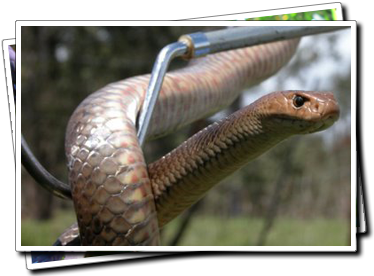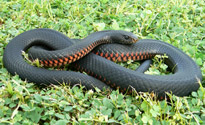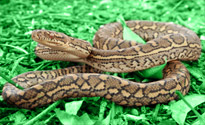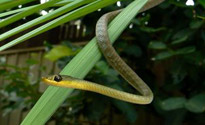Snake Bite First Aid
South-east Queensland is home to approximately 27 snake species, but only 13 are regarded as medically significant. If you are unlucky enough to be bitten, here is a guide of what and what not to do in the event of a snake bite.
NOTE: All snake bites should be treated as venomous especially in the absence of reliable identification and first aid action should be applied immediately with Pressure Immobilisation Bandaging and call 000.

Signs and Symptoms:
In the majority of scenarios bites from venomous snake species are somewhat pain free, even to the point in some cases that unsuspecting people have been unaware of the bite. The bite itself may appear somewhat innocuous more often resembling lacerations or scratches than the two puncture marks synonymous with most peoples expectation of a snake bite.
Occasional bruising may occur however bleeding is generally minimal. A lymphatic response is common and may be quite severe in some cases. Initial symptoms may include headache, nausea, vomiting, diarrhoea, irritability, light sensitivity, disorientation; inconsistent coagulation and potentially a loss of consciousness. Secondary symptoms may include difficulty swallowing, double vision, drooping of the eyelids, blood in the urine, abdominal pain, rapid increase in heart rate. Severe symptoms which may in extreme cases lead to death include marked loss of color or discoloration resulting in circulatory failure, loss of limb function due to paralysis and respiratory muscular apathy leading to respiratory failure.
The consistency of these events is unpredictable and a number of factors must be considered when assessing an individual's response to envenomation. These factors may include:
- Age: In particular the elderly and young children face elevated levels of vulnerability when an envenomation has occurred. This is a reflection of often diminished immunity in the elderly and an under developed immunity in young children.
- General health including current medical condition: Those supporting a pre-existing condition such as a compromised heart, kidney or liver may be at greater risk dependant on the venom constituents specific to a venom type. People with a poor general level of fitness or carrying excess weight may also be more susceptible to the effects of some venom.
- Time between the bite and receipt of first aid: Time is critical when considering the main aim of supportive first aid is to inhibit the progression of venom via lymphatic movement. The application of first aid a soon as possible cannot be overstated.
- Activity of the individual between bite and receipt of first aid: As venom travels via lymphatic movement the absence of muscular activity is paramount. Running to a car for a bandage or to seek assistance may be enough to progress the venom to a point where the benefit of first aid treatment is greatly reduced.
- Activity post first aid application: The key to venom suspension is the absence of movement. Even extremities such as fingers and toes should be kept motionless as these small movements will assist venom progression.
- Species of snake, subsequent toxicity and amount of venom received by the individual: Snake toxicity is highly variable across species represented in Australia. The amount of venom received may vary from cases to case but generally those instances where snakes have been intimidated, harassed or harmed tend to result in greater venom expenditure when a bite is delivered.
- Location of the bite: Envenomation on a limb can be more readily contained with adequate first aid application as opposed to those on the head or torso where the relevant first aid technique is rendered largely ineffective.
The time frame, in which symptoms become evident and escalate, again is highly variable and not easily quantified. Where a number of the factors presented above are adverse symptomatic onset may be rapid in the case of bites from highly toxic species. Anaphylaxis is also a common cause of symptomatic response where although the toxicity of a snake may not be considered of high risk an individual's physiological response may promote an escalated allergic reaction to compounds particular to that venom type.
Lymphatic progression: the vital ingredient.
Before illustrating correct first aid it's of great benefit to understand the mechanism by which venom actually progresses from the bite site and throughout the body. In the vast majority of cases venom moves initially through the secondary circulatory system, otherwise known as the lymphatic system. Where a bite is received directly to a vein or artery progression may be afforded by this means however this event is rare.
The intention of first aid application is to greatly inhibit the progression of venom through the body. To do this, the key ingredients when considering the reduction of lymphatic movement are compression and immobilisation. Pressure applied by a bandage reduces opportunity for lymphatic function and in turn immobilisation disengages voluntary and involuntary muscular movement. The application of correct first aid that implements this strategy has proven to be highly effective and undoubtedly not only saved many lives but has reduced the onset of symptomatic responses prior to receiving increased levels of intervention such as antivenin administration.
Snake Bite First Aid
The implementation of current first aid is critical immediately after receipt of a bite from a snake. The "pressure-immobilisation" technique is currently recommended by all major health organisations within Australia. A number of "do nots" are applicable to snake bite management. These are as follows:
Do not try to catch or kill the snake. Statistically 95% of people that are admitted to hospitals for snakebite treatment have attempted to catch, kill or otherwise engage with the snake.
Do not wash the bite site. In many cases the application of a Venom Detection Kit (VDK) may be applied to assist in identifying the snake responsible. Residual venom from the bite site is in this instance the most accurate means of identifying a snake where a specimen is not provided. This in turn means that the specific antivenin is administered rather than a polyvalent which carries higher risk of anaphylactic response.
Do not give food or drink - In the event of significant delay or where dehydration is an issue small sips of water are acceptable. Alcohol especially should be avoided.
Do not lance or suck the bite. Sucking the venom out may cause a secondary envenomation and is likely not to remove all the venom anyway.
Do not apply a tourniquet. This method is ineffective and can result in severe injuries to the patient due to loss of circulation to the effected limb. When released the rapid progression of venom may cause an onset of symptomatic response that is highly accelerated.
Do not unnecessarily move the person bitten. Application of first aid should be done as soon as the bite is received or when first noticed. Again unnecessary movement results in lymphatic activity which is what is to be avoided at all costs.
Do not remove the bandages or splints at any stage after they are applied. Only when additional medical support under direction of a treating doctor should bandages be removed. Only when appropriate antivenom and resuscitation equipment is on hand should any first aid be removed.
Correct First Aid For Snake Bite:
Snake bites can occur anywhere on the body. Correct first aid for each of the following body divisions is provided. These include:
- Limbs.
- Torso.
- Head or neck.
The procedure for correct first aid should be implemented as follows:
Bites to a limb:
- Immediately immobilise and reassure the bitten person. Remember this is critical to the arrest of venom advancement. As a first aider it is important you remain calm to instil confidence in the person you are treating.
- Instruct a bystander to call 000 and immediately proceed with first aid procedure. In the event a bystander is not available utilise a speaker phone option so you can communicate to an emergency service whilst applying first aid.
- Use a broad compression or crepe style bandage beginning at the base of the limb. Application should be at the same pressure used to immobilise a sprain. Remember we are endeavouring to immobilise lymphatic movement not restrict blood flow. In the event no bandages are at hand the use of torn clothing, towelling or even panty hose can be used as an alternative. Cut clothing rather than remove it if required. Leave clothing on if immobilisation is going to be compromised.
- Continue the bandaging upwards until the bandage expires. Take the second bandage if required and ensure the entire limb is bandaged.
- Apply a splint to a leg or gently place the arm across the body in a sling. A splint must be a rigid elongate object such a stick, section of a fishing rod or tent pole and preferably extend the length of the leg. Fix the splint to the leg with another bandage, strips of material or shoe laces in such a manner that the leg is completely immobilised.
- Maintain complete immobilisation for the entire body as much as possible. Where possible assistance should be brought to the patient rather than having them subject to unwanted movement. In the event movement is necessary support the patient as much as possible.
Bites to a Torso:
The compression technique in this instance is varied due to the structure of the torso as opposed to an elongate limb.
- Immediately immobilise and reassure the bitten person. Remember this is critical to the arrest of venom advancement particularly in the case of a bite to the trunk or torso. As a first aider it is important you remain calm to instil confidence in the person you are treating.
- Instruct a bystander to call 000 and immediately proceed with first aid procedure. In the event a bystander is not available utilise a speaker phone option so you can communicate to an emergency service whilst applying first aid.
- Maintain firm consistent pressure be applied directly to the bite location.
- Maintain complete immobilisation for the entire body as much as possible. Where possible assistance should be brought to the patient rather than having them subject to unwanted movement. In the event movement is necessary support the patient as much as possible.
Bites to a Head or Neck:
- Immediately immobilise and reassure the bitten person. Remember this is critical to the arrest of venom advancement particularly in the case of a bite to the head or neck. As a first aider it is important you remain calm to instil confidence in the person you are treating.
- Call 000 and immediately.
- No first aid methodology is relevant to bites to the head or neck
- In this instance complete immobilisation is absolutely critical. Where possible assistance should be brought to the patient rather than having them subject to unwanted movement. In the event movement is necessary support the patient as much as possible.
For further information regarding snake bite management visit paradisefirstaid.com.au
Copyright © 2015 Toowoomba Catchers, All rights reserved.
Web site by Serenity Computer Services

.jpg)


